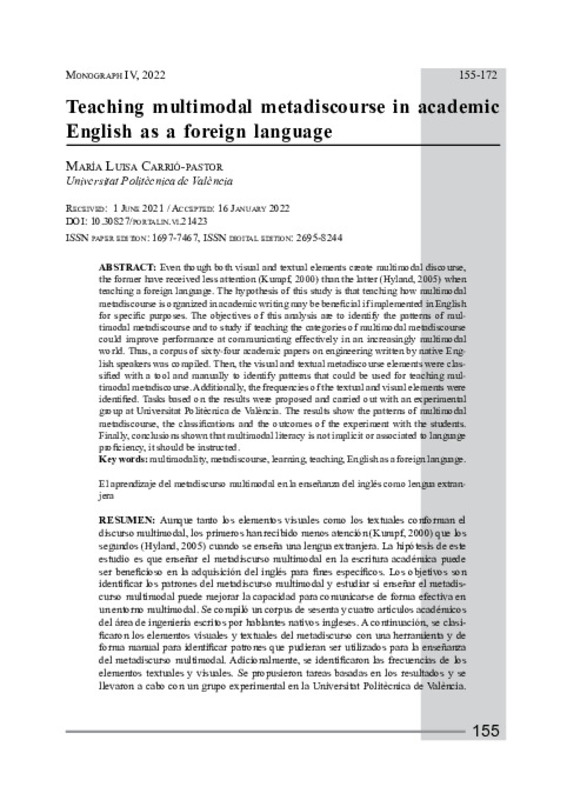|
Resumen:
|
[ES] Aunque tanto los elementos visuales como los textuales conforman el discurso multimodal, los primeros han recibido menos atención (Kumpf, 2000) que los segundos (Hyland, 2005) cuando se enseña una lengua extranjera. ...[+]
[ES] Aunque tanto los elementos visuales como los textuales conforman el discurso multimodal, los primeros han recibido menos atención (Kumpf, 2000) que los segundos (Hyland, 2005) cuando se enseña una lengua extranjera. La hipótesis de este estudio es que enseñar el metadiscurso multimodal en la escritura académica puede ser beneficioso en la adquisición del inglés para fines específicos. Los objetivos son identificar los patrones del metadiscurso multimodal y estudiar si enseñarlo puede mejorar la capacidad para comunicarse de forma efectiva en un entorno multimodal. Se compiló un corpus de sesenta y cuatro artículos académicos del área de ingeniería escritos por hablantes nativos ingleses. A continuación, se clasificaron los elementos visuales y textuales del metadiscurso con una herramienta y de forma manual para identificar patrones que pudieran ser utilizados para la enseñanza del metadiscurso multimodal. Adicionalmente, se identificaron las frecuencias de los elementos textuales y visuales. Se propusieron tareas basadas en los resultados en un grupo experimental en la UPV. Los resultados muestran los patrones del metadiscurso multimodal, las clasificaciones y los resultados del experimento. Finalmente, en las conclusiones se evidenció que la dimensión multimodal no está implícita o asociada al conocimiento de una lengua, si no que ha de ser enseñada.
[-]
[EN] Even though both visual and textual elements create multimodal discourse, the former have received less attention (Kumpf, 2000) than the latter (Hyland, 2005) when teaching a foreign language. The hypothesis of this ...[+]
[EN] Even though both visual and textual elements create multimodal discourse, the former have received less attention (Kumpf, 2000) than the latter (Hyland, 2005) when teaching a foreign language. The hypothesis of this study is that teaching how multimodal metadiscourse is organized in academic writing may be beneficial if implemented in English for specific purposes. The objectives of this analysis are to identify the patterns of multimodal metadiscourse and to study if teaching the categories of multimodal metadiscourse could improve performance at communicating effectively in an increasingly multimodal world. Thus, a corpus of sixty-four academic papers on engineering written by native English speakers was compiled. Then, the visual and textual metadiscourse elements were classified with a tool and manually to identify patterns that could be used for teaching multimodal metadiscourse. Additionally, the frequencies of the textual and visual elements were identified. Tasks based on the results were proposed and carried out with an experimental group at Universitat Politecnica de Valencia. The results show the patterns of multimodal metadiscourse, the classifications and the outcomes of the experiment with the students. Finally, conclusions shown that multimodal literacy is not implicit or associated to language proficiency, it should be instructed.
[-]
|
|
Agradecimientos:
|
This paper shows some of the findings of the research project "Identification and Analysis of Metadiscourse Strategies in Research Articles in English and Spanish" with reference FFI2016-77941-P, funded by the Ministerio ...[+]
This paper shows some of the findings of the research project "Identification and Analysis of Metadiscourse Strategies in Research Articles in English and Spanish" with reference FFI2016-77941-P, funded by the Ministerio de Economía y Competitividad, Spain (2017-2020).
[-]
|









